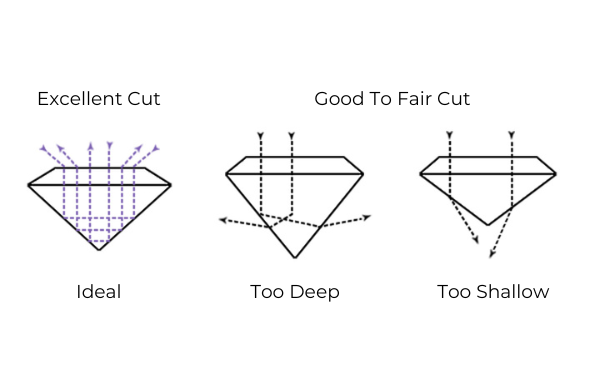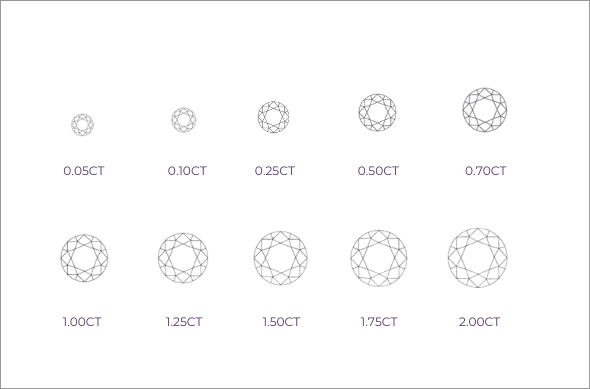Stone Guide
What Are The 4C's Of Diamonds?
The 4C's grading system is the standard, international technique for determining the value of a diamond. To measure a diamond's quality and worth, this grading method employs the four C's of diamonds, which stand for Carat, Cut, Clarity, and Color.
- Cut
- Carat
- Clarity
- Color
Cut
Cut is the most crucial of the four C's. The manner in which a diamond is cut influences its brilliance, sparkle, and fire, as well as its final worth and beauty. Without these characteristics, no matter what the carat weight, color, or clarity, the diamond is worthless. Cut and shape are commonly confused, although they are not the same thing; cut is concerned with symmetry and proportion, whereas shape is concerned with the diamond's contour and form.

What Impacts Diamond Cut Quality?
The only one of the four C's that is altered by human hands is Cut. Two diamonds may have the same clarity, colour, and carat weight, but the cut is what distinguishes one from the other. Simply said, cut determines the quality and degree of a diamond's shine. The cut of a diamond is determined by three factors:
Cut Precision
How the dimensions and angles connect to the various portions of the stone.
Symmetry
The precision with which the many facets of a diamond connect and meet.
Polish
The intricacies and positioning of the facet shapes, as well as the diamond's exterior finish.
Shapes
-
Round
-
Oval
-
Cushion
-
Princess
-
Emerald
-
Heart
-
Marquise
-
Pear
-
Baguette
Round
When it comes to diamonds and engagement rings, round brilliant cut diamonds are the go-to peak of excellence. Round shaped diamonds are known for their particular brightness and lustre, and they typically have 57 facets or cuts that are mathematically calculated for optimum sparkle and the concealment of imperfections. This is the stone form for those who like a more traditional look.
Oval
Known for their ability to bridge the gap between classic and unique, oval diamonds allow their wearer to bear the 57 facet sparkles known for brilliant cuts in a more unique shape that expresses individuality. The oval's lengthy form coats the finger with shine, and each oval has a tiny difference, allowing for more creative design options.
Cushion
The cushion diamond is a softened square with rounded sides that is one of the earliest cutting types traditionally known as "mine cut" because of how beautiful the diamonds gleamed in candlelight. The cut has been adjusted since the 1700s, and this historical relationship may explain why it is the most popular celebrity diamond shape.
Princess
The princess shape, which was invented in the 1970s, is a contemporary spin on the brilliant cut and shines distinctively with 57 facets that easily hide slight defects. Clean lines and clean edges meet in this popular diamond shape, which has rapidly made its way to the centre of our hearts, where every princess should be.
Emerald
Emerald cut diamonds are smooth, with geometric lines and crisp edges that highlight the diamond's quality and colour. This stone form, developed in the 1500s for emerald cutters and sometimes referred to as a step cut, has since captivated the gaze of diamond lovers with its depth and simple beauty that elongates the finger and demonstrates the difference high clarity diamonds can offer.
Heart
Heart-shaped jewels are traditional symbols of love, and they are cut with a perfect length-to-width ratio to ensure precisely symmetrical curves. The heart-shaped diamond is a fantastic option for the traditional romantic since it is sentimental and as uncommon as real connection.
Marquise
The Marquise shape is elongated with tapering tips at both ends. Its design allows the cutter to optimize carat weight, creating the illusion of a larger-looking diamond, and it flatters the finger, making it appear longer. The length-to-width ratios of the most conventional marquise-cut diamonds range between 1.75 and 2.25. Diamond Hybrid: The length-to-width ratio of the Marquise cut Diamond Hybrid is 2:1, which is desired, indicating that the length of the stone is approximately twice the breadth of the stone.
Pear
The pear form is most similar to a 'teardrop' in shape, with a rounded end on one side and a tapering tip on the other. The pear is a feminine form, and the more extended it is, the slim your fingers will seem. The length and breadth ratios of pear shape diamonds can vary, with the most frequent ratios being between 1.45 and 1.75.
Baguette
A baguette cut is similar to an emerald cut in that it is a rectangle or trapezoidal step cut with fewer facets and no bevels. Trilliant/Triangle, Half Moon, Kite, Old European, Old Mine Cut, and Trapezoid are some more fancy diamond forms.
Carat
The carat weight of a diamond also influences its price, and it is undoubtedly the most apparent feature of a diamond. It is also the most objective of the four C's. It should be noted that carat and size are not synonymous; carat refers to the actual weight of a diamond, whilst size refers to its dimensions. In general, the bigger the diamond, the higher the price per carat. Carat weight can vary depending on the form of the diamond, such as round brilliant, princess, pear, oval, cushion, marquise, emerald, radiant, or heart. A diamond with a higher carat weight may look larger, and two diamonds with the same carat weight may differ in size if one is cut deeper than the other. In other words, carat weight does not always correspond to size. The sizes shown here are presented for proportionality. The carat size shown in the images is not the actual carat size.

Clarity
Internal defects in diamonds are known as inclusions. Any diamond with visible flaws to the unassisted eye is rejected by VM JEWELLERY

FL
FL diamonds are
Flawless
IF
IF diamonds are Internally
Flawless
VVS1 VVS2
VVS diamonds (1 & 2) are
Very Very Slightly Included
VS1 VS2
VS diamonds (1 & 2) are
Very Slightly Included
SI1 SI2
SI diamonds (1 and 2) are
Slightly Included
I1 I2 I3 I4
I diamonds (1, 2 and 3) are
Included
NATTS
PK1 PK2 PK3 PK4
Color
The hue of a diamond is referred to as colour, and it is based on the GIA diamond colour scale. The absence of colour has an impact on the grade and value of a diamond.This section's gemological requirements only apply to individually registered engagement diamonds set in certain ring designs.


